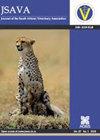兽医学生抗菌素耐药性的知识和观念对未来动物卫生抗菌素处方的影响,南非
IF 0.9
4区 农林科学
Q3 VETERINARY SCIENCES
Journal of the South African Veterinary Association
Pub Date : 2019-10-17
DOI:10.4102/jsava.v90i0.1765
引用次数: 21
摘要
了解兽医学生对抗菌素耐药性(AMR)的知识和看法,作为未来潜在的抗菌素处方者,可能是改善抗菌素耐药性管理的一个机会。比勒陀利亚大学兽医专业预科学生(n = 42)和大四学生(n = 29)完成了问卷调查,以确定他们对抗菌素耐药性的了解和认知。在71名受访者中,混合执业(48%)和小动物执业(45%)是毕业后最受欢迎的职业选择,最不受欢迎的是大体病理学领域。超过80%的受访者认为兽医从业人员滥用抗菌素导致了抗生素耐药性,98.6%的受访者认为农民滥用抗菌素鼓励了抗生素耐药性的发展,特别是在食用动物(60.6%)中,这一比例高于伴侣动物(50.7%)。在抗菌药物滥用的排名上,预科生和大四学生之间的一致性是公平的(36.4%;Kappa 0.3),学生滥用最多的抗菌药物依次为四环素类、青霉素类、磺胺类和氨基糖苷类。在训练和势场应用之间存在很大的差异,并且在正确匹配抗菌素与各自的抗生素类别方面存在差异。对抗菌素临床应用的反应也有很大差异。尽管对兽医学生进行了明显的抗生素耐药性教学,但在将理论概念转化为临床应用方面可能存在差距,因此需要进行有针对性的抗菌药物处方和管理培训,以弥合这些潜在的已确定差距。本文章由计算机程序翻译,如有差异,请以英文原文为准。
Implication of the knowledge and perceptions of veterinary students of antimicrobial resistance for future prescription of antimicrobials in animal health, South Africa
Understanding the knowledge and perceptions of veterinary students of antimicrobial resistance (AMR) as potential future prescribers of antimicrobials may serve as an opportunity to improve stewardship of AMR. Pre-final (n = 42) and final (n = 29) year veterinary students of the University of Pretoria completed questionnaires to determine their knowledge and perceptions of AMR. Of the 71 respondents, mixed practice (48%) and small animal practice (45%) were the most preferred career choices post-graduation, with the field of gross pathology being the least preferred. Over 80% of the respondents believed that veterinary practitioners’ misuse of antimicrobials contributes to AMR and a higher percentage (98.6%) believed that farmers’ misuse of antimicrobials encourages the development of AMR, in particular, in food animals (60.6%) compared to companion animals (50.7%). Agreement in the ranking of abuse of antimicrobials between pre-final and final year students was fair (36.4%; kappa 0.3), and the most abused antimicrobials in descending order listed by the students were tetracyclines, penicillins, sulphonamides and aminoglycosides. There was wide disparity between training and potential field application, as well as variations in the correct matching of antimicrobials to their respective antibiotic classes. Responses to the clinical application of antimicrobials also varied widely. Despite the apparent teaching of AMR to veterinary students, gaps may exist in the translation of theoretical concepts to clinical applications, hence the need for focused and targeted antimicrobial prescription and stewardship training to bridge these potential identified gaps.
求助全文
通过发布文献求助,成功后即可免费获取论文全文。
去求助
来源期刊

Journal of the South African Veterinary Association
VETERINARY SCIENCES-
CiteScore
1.50
自引率
0.00%
发文量
23
审稿时长
22 weeks
期刊介绍:
The Journal of the South African Veterinary Association is a contemporary multi-disciplinary scientific mouthpiece for Veterinary Science in South Africa and abroad. It provides veterinarians in South Africa and elsewhere in the world with current scientific information across the full spectrum of veterinary science. Its content therefore includes reviews on various topics, clinical and non-clinical articles, research articles and short communications as well as case reports and letters.
 求助内容:
求助内容: 应助结果提醒方式:
应助结果提醒方式:


